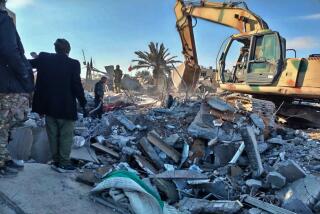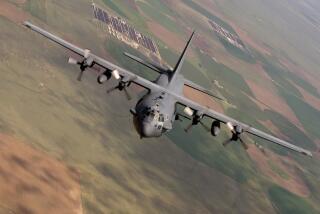Enemy Territory Divided Into ‘Killing Boxes’ for Aerial Onslaught : Strategy: One by one, specific areas are attacked. This appears to disrupt Iraqi efforts for command unity.
- Share via
EASTERN SAUDI ARABIA — The air war against Iraq has in recent days become a violent, methodical search-and-destroy campaign in which individual regions of Kuwait and southern Iraq are being singled out for furious aerial barrages carried out with almost mathematical precision.
The entire theater of operations has been divided into a grid of “killing boxes,” each several miles long and wide, which allied aircraft are pounding one by one in an attempt to snuff out all Iraqi military activity before moving on to the next, U.S. Air Force officials said.
The new zoned bombing raids may be one factor in what allied officials say is an apparent breakdown in the Iraqi army’s ability to function as a cohesive unit throughout Kuwait.
“They have stopped operating as a national army (pursuing) theater objectives,” said Capt. Jessie Morimoto, chief of operation location intelligence for the U.S. Air Force near the Saudi-Kuwaiti border. The Iraqis instead have begun to operate as “small pockets of troops defending themselves,” she said.
Pilots returning from bombing missions report that large, blackened craters are beginning to cover the landscape, and the oil-filled trenches around many Iraqi troop positions have been set ablaze, covering as much as a third of the countryside with black smoke.
“Everything in the country appears bombed out,” said Maj. Vince Wisniewski, whose four-aircraft formation has in the past week dropped an average of 100,000 pounds of bombs a day in the Kuwaiti theater.
“We’re starting to see miles of blackened earth and bomb craters,” another pilot said. “The Iraqis are trying to set up new routes to get in the theater. We see some resupply trying to move, but they’re mostly unsuccessful.”
Under the new zoned bombing approach, allied aircraft no longer fly helter-skelter into Iraq and Kuwait, attacking selected targets and prowling the countryside for whatever tanks, troop emplacements or other military targets might be available on the return run.
“It was hit or miss before,” said Capt. Dewey Gay, a pilot with the Air Force’s 33rd Tactical Fighter Squadron.
Now, pilots are instructed to focus on an individual zone, identified by a set of letters and numbers, in which they concentrate on destroying all artillery, tanks, observation towers, surface-to-air radar sites and any other apparent military targets before moving on to another “killing box.”
The result is a merciless barrage on Iraqi troops encamped in a particular region, allied pilots say.
“Down there, it is hell,” said Air Force Capt. Orlando Cisneros. But, he added, “This is war. It’s not funny or pleasant, but it is necessary.”
Allied pilots had complained that too much of their time over the battlefield had been wasted searching for targets on which to drop their bombs. In the increasingly crowded skies over Kuwait and southern Iraq, the process of target hunting prevented other planes from moving quickly into nearby areas to drop their ordnance.
A new system of air traffic control has helped implement the zoned assaults.
F-16 fighter pilots have been assigned to act as directors of air operations over each active “killing box.” The fighter pilots spot some targets themselves, take in reports of others from bombers operating in the zone, then direct new incoming bombers to the targets as they reach the area.
The airborne air traffic controller is also responsible for keeping down the number of aircraft in the zone at any one time and for pacing incoming sorties so that aircraft can be efficiently refueled at air bases in northern Saudi Arabia.
Much of the information about targets within a specific zone is accumulated from pilot reports on previous overflights of the area. Morimoto interviews pilots returning from bombing runs and relays the information to a tactical air control center in the Saudi capital of Riyadh, which designates future targets and chooses which aircraft are best to attack them.
“We depend on accurate coordinates and (target) description from pilot reports,” Morimoto said. In Kuwait, she said, “we can tell where the troops have been and moved, and the tactics they’re employing.”
More to Read
Sign up for Essential California
The most important California stories and recommendations in your inbox every morning.
You may occasionally receive promotional content from the Los Angeles Times.













